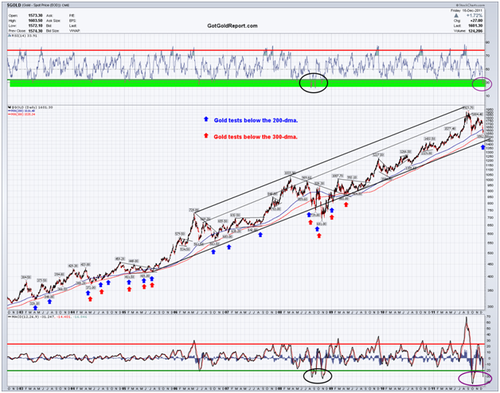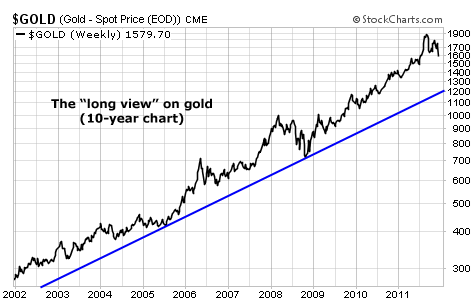(Kitco News) - The economic slowdown expected in China and a potential recession in Europe is expected to pinch commodities demand at least early in 2012.
Just how much it will dent demand is up for debate. Some market watchers have lowered their price forecasts for the year across the board, and others said it might be better to be on the sidelines for the first half of 2012.
Yet others said 2012 could be a year that rewards investors who are choosy in their commodity selections. Commodities analysts’ who see value in some markets are selecting livestock and gold as two areas that might outperform the sector as a whole.
The concerns about the economic health of the eurozone hit nearly all financial markets, commodities included, as investors moved out of risky assets and sought out safe havens, in particular the U.S. dollar. This desire to preserve capital in the most liquid market around had a double whammy effect on commodities. Not only were they hit by thoughts that a recession in Europe would ding demand, but being valued in greenbacks made the goods become more costly as the dollar rose.
Hussein Allidina, head of commodity strategy at Morgan Stanley, said the reason for the dollar’s strength in this case is important. “Historically, we have seen periods where both the U.S. dollar and commodities have rallied, owing to strength in the U.S. economy.
Conversely, any dollar strength in 2012 is more likely to be a flight to quality. The implication for the global economic environment under such a scenario is a bearish signal for commodity demand,” he said.
Karl Setzer, commodity trading adviser at MaxYield Cooperative in Iowa, said the gain the dollar had a significant impact on the grain markets, which were already in a downtrend. Corn and soybeans had made their high for the year on Aug. 30 and Sept. 1, respectively. Wheat, which is on a different growing cycle that corn and soybeans, saw its highs set in February and has been falling since.
Regarding corn and soybeans, Setzer said, “what we’ve seen over the last quarter is a fundamental shift. Over October, November and December, there’s been a major shift where we’ve seen demand for grain just imploded. Nobody wants grain at these prices. It’s starting to affect the overall dynamics.”
Grain markets have rallied in the last week of the year, but part of that is likely year-end book squaring. This late rally has helped the overall performance of corn, but soybeans and wheat remain weak. Through late December corn prices are up 12% on the year, while soybeans were down about 9% and wheat was down 25%.
As an example of the impact of high prices, a stronger dollar and lower demand, Setzer said corn exports are down about 14% year-to-date. While ethanol production in the U.S. is up a bit, it hasn’t offset the slump in foreign sales and feed demand domestically and globally is also down.
Grains aren’t the only commodities that have been weakening in the late-2011 rout. Just about any other commodity, whether it is livestock, sugar, coffee, or metals, have all seen values fall.
Shawn Hackett, president, Hackett Financial Advisors, said it’s not surprising to see price breaks across the board, given the economic outlook and financial jitters. He said more losses are possible into the first-half of 2012, with the second-half of the year a time for these markets to build a base in time for a 2013 rally. This is especially true if the market is setting up for a repeat of 2008.
“Like in 2008 we hit the lows hard. In the end of 2008 to the spring of 2009 it bottomed out. We had the surge from 2009 to spring 2010. I see a lot that’s analogous to 2009. (At the time) we had a lower first half and then rallied into the second half of the year. We could really rock and roll in 2013 where we could have another exciting up move,” Hackett said.
Because he believes that more losses are commodity to the raw materials market, he advises staying on the sidelines.
Rabobank said they see lower average prices across the board for agricultural commodities. Aside from the usual risk weather brings to crops, there are four other risks: economic slowdown, the U.S. dollar and speculator involvement, policy risk and capacity constraints.
Higher supplies of most commodities and slowing economic growth could mean lower prices, but that emerging market demand will prevent a collapse, they said. Lower prices could encourage inventory-building, especially in the emerging markets, they added.
The rise in the dollar has hit commodities, but by 2012, dollar weakness may reassert itself, they said, once the focus from troubles in the EU is removed. Monetary policy in the U.S. remains loose and there is still the possibility of more quantitative easing. If that is the case the U.S. grain markets will benefit the most from the dollar falling.
Further, with prices expected to be down from 2011’s levels, it removes the specter of inflation and also a compelling reason for speculators to buy agricultural commodities indiscriminately, Rabobank said.
Their base case for commodities is that agricultural markets will stumble along in a low growth global economic environment.
NOT EVERYONE’S TOTALLY BEARISH
Allidina said because economic growth is expected to be low, it isn’t “prudent” to buy commodities across the board. He said Morgan Stanley favors “commodities with supply constraint stories are … likely to outperform as demand is unlikely to be a material contributor to tighter balances, at least in” the first half of 2012.
John Person, president, NationalFutures.com, said livestock prices should do well in 2012, with cattle prices leading the upside.
He said the drought in Texas was severe enough for ranchers to cull herds, which has lower supply. As beef rises, pork should benefit from consumers who are looking for a cheaper red-meat alternative. But, he said, those looking to buy beef should think about getting long the summer futures contract months, rather than the nearby contracts. That’s because as ranchers bring more cattle into slaughter, that puts more supply on the market in the near-term.
Allidina also favors cattle, expecting 2012’s price for live cattle to rise 10 cents a pound over 2011’s average price, to $1.25 a pound. Feeder cattle prices are expected to rise to $1.49 a pound in 2012, versus 2011’s average price of $1.34.
“Continued strength in U.S. beef export demand, coupled with high feed costs and contracting feeder cattle supply all bode well for U.S. live cattle prices,” he said.
Rabobank is less enamored of livestock, but said of all the animal markets, beef may do best. They said the reduction in demand in the U.S. because of reduced income and altered diets is being offset by emerging market demand. They also said the high number of speculators in the livestock markets leaves it vulnerable to selling.
Person also said there’s a lot of interest by investors to buy natural gas, especially as the need for cleaner-burning fuels increases. “Everyone has wanted to get long, but I’d be a careful buyer. I like nat gas under $4 (per million BTUs),” he said.
Allidina warned that natural gas remains in a significantly oversupplied situation in 2012, even as production growth is slowing. But he agreed that new emission regulations should benefit natural gas and help create a floor for prices, adding that “slowing gas-directed drilling may begin to help tighten balances by late 2012.”
He also likes gold for 2012, with a forecast of $2,200 an ounce. “The defensive nature of gold should continue to support investment demand as investors look for safe havens. A continued low or negative real interest rate environment will also provide support,” he said.
Source; http://www.kitco.com/reports/KitcoNews20111229DeC.html












